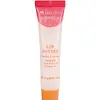What's inside
What's inside
 Key Ingredients
Key Ingredients

 Benefits
Benefits

 Concerns
Concerns

 Ingredients Side-by-side
Ingredients Side-by-side

Caprylic/Capric Triglyceride
MaskingPhytosteryl Isostearyl Dimer Dilinoleate
EmollientSimmondsia Chinensis Seed Oil
EmollientDiisostearyl Malate
EmollientHydrogenated Polyisobutene
EmollientBis-Diglyceryl Polyacyladipate-2
EmollientHydrogenated Castor Oil Dimer Dilinoleate
Skin ConditioningBeeswax
Emulsion StabilisingSynthetic Wax
AbrasiveMicrocrystalline Wax
Emulsion StabilisingPolyethylene
AbrasiveCocos Nucifera Seed Butter
Skin ConditioningTocopheryl Acetate
AntioxidantCandelilla Wax Esters
Parfum
MaskingPolyglyceryl-2 Triisostearate
EmulsifyingCopernicia Cerifera Wax
CI 19140
Cosmetic ColorantCI 77891
Cosmetic ColorantPolyglyceryl-2 Diisostearate
EmulsifyingCI 17200
Cosmetic ColorantWater
Skin ConditioningButylene Glycol
HumectantHc Red No. 20
Monascus/Rice Ferment
AntioxidantBHT
AntioxidantCaprylic/Capric Triglyceride, Phytosteryl Isostearyl Dimer Dilinoleate, Simmondsia Chinensis Seed Oil, Diisostearyl Malate, Hydrogenated Polyisobutene, Bis-Diglyceryl Polyacyladipate-2, Hydrogenated Castor Oil Dimer Dilinoleate, Beeswax, Synthetic Wax, Microcrystalline Wax, Polyethylene, Cocos Nucifera Seed Butter, Tocopheryl Acetate, Candelilla Wax Esters, Parfum, Polyglyceryl-2 Triisostearate, Copernicia Cerifera Wax, CI 19140, CI 77891, Polyglyceryl-2 Diisostearate, CI 17200, Water, Butylene Glycol, Hc Red No. 20, Monascus/Rice Ferment, BHT
Diisostearyl Malate
EmollientPolyisobutene
Hydrogenated Polydecene
EmollientButyrospermum Parkii Butter
Skin ConditioningCaprylic/Capric Triglyceride
MaskingOryza Sativa Bran Wax
Skin ConditioningMicrocrystalline Wax
Emulsion StabilisingHydrogenated Olive Oil Lauryl Esters
Emulsion StabilisingPolyethylene
AbrasiveBeeswax
Emulsion StabilisingDimethicone
EmollientEuphorbia Cerifera Wax
Octyldodecanol
EmollientCopernicia Cerifera Wax
Parfum
MaskingRosa Canina Fruit Oil
EmollientEthylcellulose
Isostearyl Alcohol
EmollientHydrogenated Dilinoleyl Alcohol
EmollientEclipta Prostrata Extract
Skin ConditioningCyclomethicone
EmollientMelia Azadirachta Leaf Extract
Skin ConditioningMoringa Oleifera Seed Oil
EmollientDiisostearyl Malate, Polyisobutene, Hydrogenated Polydecene, Butyrospermum Parkii Butter, Caprylic/Capric Triglyceride, Oryza Sativa Bran Wax, Microcrystalline Wax, Hydrogenated Olive Oil Lauryl Esters, Polyethylene, Beeswax, Dimethicone, Euphorbia Cerifera Wax, Octyldodecanol, Copernicia Cerifera Wax, Parfum, Rosa Canina Fruit Oil, Ethylcellulose, Isostearyl Alcohol, Hydrogenated Dilinoleyl Alcohol, Eclipta Prostrata Extract, Cyclomethicone, Melia Azadirachta Leaf Extract, Moringa Oleifera Seed Oil
Ingredients Explained
These ingredients are found in both products.
Ingredients higher up in an ingredient list are typically present in a larger amount.
Beeswax is natural wax produced by honey bees and can be synthetically created. It consists mainly of fatty acid esters and long-chain alcohols.
In cosmetics, beeswax is a emollient. Due to its waxy structure, it creates a protective barrier. This barrier prevents water from evaporating off the skin.
This may not be a good ingredient for oily skin. We recommend speaking with a professional if you have concerns.
Beeswax cannot be removed with water, but can be taken off with an oil cleanser.
Beeswax is also antiseptic and contains vitamin A.
Learn more about BeeswaxThis ingredient is an emollient, solvent, and texture enhancer. It is considered a skin-softener by helping the skin prevent moisture loss.
It helps thicken a product's formula and makes it easier to spread by dissolving clumping compounds.
Caprylic Triglyceride is made by combining glycerin with coconut oil, forming a clear liquid.
While there is an assumption Caprylic Triglyceride can clog pores due to it being derived from coconut oil, there is no research supporting this.
Learn more about Caprylic/Capric TriglycerideCopernicia Cerifera Wax comes from a palm tree native to Brazil; another name for this ingredient is Carnauba Wax.
This ingredient is used to thicken texture and also leaves behind a film when applied.
Fun fact: This wax has the highest melting point of all natural waxes and low solubility.
Learn more about Copernicia Cerifera WaxDiisostearyl Malate is an emollient and most often used in lip products. It comes from isostearyl alcohol, a fatty acid, and malic acid, an AHA.
As an emollient, Diisostearyl Malate helps create a thin film on your skin to trap moisture in. This helps keep your skin soft and smooth.
Microcrystalline Wax is created by de-oiling petroleum. It is highly refined and purified before being added to cosmetics.
Microcrystalline Wax is used to enhance the texture and create even consistency. It helps stabilize a product by preventing ingredients from separating.
Parfum is a catch-all term for an ingredient or more that is used to give a scent to products.
Also called "fragrance", this ingredient can be a blend of hundreds of chemicals or plant oils. This means every product with "fragrance" or "parfum" in the ingredients list is a different mixture.
For instance, Habanolide is a proprietary trade name for a specific aroma chemical. When used as a fragrance ingredient in cosmetics, most aroma chemicals fall under the broad labeling category of “FRAGRANCE” or “PARFUM” according to EU and US regulations.
The term 'parfum' or 'fragrance' is not regulated in many countries. In many cases, it is up to the brand to define this term.
For instance, many brands choose to label themselves as "fragrance-free" because they are not using synthetic fragrances. However, their products may still contain ingredients such as essential oils that are considered a fragrance by INCI standards.
One example is Calendula flower extract. Calendula is an essential oil that still imparts a scent or 'fragrance'.
Depending on the blend, the ingredients in the mixture can cause allergies and sensitivities on the skin. Some ingredients that are known EU allergens include linalool and citronellol.
Parfum can also be used to mask or cover an unpleasant scent.
The bottom line is: not all fragrances/parfum/ingredients are created equally. If you are worried about fragrances, we recommend taking a closer look at an ingredient. And of course, we always recommend speaking with a professional.
Learn more about ParfumPolyethylene is a synthetic ingredient that helps the skin retain moisture. It is a polymer.
It is also typically used within product formulations to help bind solid ingredients together and thicken oil-based ingredients. When added to balms and emulsions, it helps increase the melting point temperature.